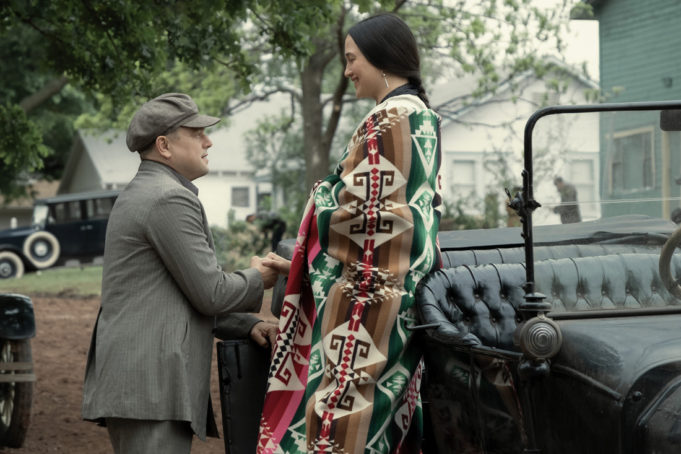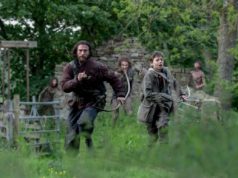In his 1995 documentary A Personal Journey with Martin Scorsese Through American Movies, the great director compares his profession to a smuggler’s. A filmmaker means to bring heavy and even controversial ideas to the public by hiding them within the confines of genre entertainment, he says. I’ve said this before but not in these pages: The world lost a great film critic when Scorsese decided to make films instead. Not that you’ll hear me complaining.
His latest piece finds him in smuggling mode. He treats the genocide of Native Americans as another Scorsese gangster movie in the mode of Goodfellas and The Irishman, and I have a sneaking suspicion that his latest is the best of the three. At 206 minutes, Killers of the Flower Moon is long and deliberate, and yet the director’s sorcery makes the time fly by.
The story is based on >David Grann’s history of the same name. The Osage Indians are among the poorest people in North America until they discover oil on their reservation in Oklahoma. Ernest John Burkhard (Leonardo DiCaprio) arrives back at his home after serving as an Army cook during World War I, and his uncle William Hale (Robert De Niro) advises him to marry Mollie Kyle (Lily Gladstone). She’s a full-blooded Osage who owns land usage rights for the oil on her property, and marrying her will make a man rich. Mollie soon inherits the land rights from her sisters and mother after they all die under shady circumstances, just like so many other Osage natives.
Scorsese is canny enough to draw the parallel between the Osage murders and the Tulsa race massacre, which happened at the same time in the county next door. Hale is seen at a movie theater watching newsreel footage of the genocide, and when Mollie’s sister’s house explodes, she says, “It’s Tulsa all over again.” Hale, who speaks the tribal language and styles himself as the Osage’s grandfatherly protector, is behind many of the murders, aiming to take the natives’ wealth for himself. The accents are different, but the Okie cowboys who carry out the killings act just like the Mafia hoods in Scorsese’s other films, uttering half-assed lies when confronted with their crimes. They’re serene in the knowledge that their boss will save them, and many of them wind up dead themselves at his behest.
The movie depicts Ernest as a weak, cowardly small-time criminal who marries Mollie and fathers her children just for her money, and that depiction may just be too generous to the real-life man. Like Henry Hill in Goodfellas and Frank Sheeran in The Irishman, Ernest is a man whose accretion of bad deeds weighs him down until it crushes him. DiCaprio vividly depicts that over the course of this film, and you won’t forget the look of fear that flashes in his eyes when an agent from the newly minted FBI (Jesse Plemons) shows up at his door. De Niro comes alive as this crafty archvillain who exerts a psychic hold on his minions even when he’s in a jail cell — he also goes to the Fort Worth Stock Show to give himself an alibi for one murder — and country singer Jason Isbell contributes a sharp turn as Ernest’s brother-in-law who holds a civil conversation with him while knowing the whole time that Ernest is plotting to kill him.
The star-making turn comes from Gladstone, the part Blackfoot native who previously out-acted a star-studded cast in Certain Women as a taciturn Montana stablehand who’s thunderstruck after seeing Kristen Stewart. Here she displays a teasing sense of humor in the early scenes when Ernest woos her then shattering grief as her family and friends are killed. She also loses an alarming amount of weight to portray a woman who’s being slowly poisoned. The final scene between her and Ernest, when she confronts him with everything he’s done and he still won’t own up to it all, is properly disturbing.
The film ends oddly but appropriately with a piece of radio theater, as the story of the Osage is reduced to a true-crime narrative glorifying the FBI to a white urban audience, complete with white actors voicing the natives and Scorsese himself appearing in the play to deliver the last word. Except it isn’t, because the closing credits show a large gathering of Osage on the Oklahoma plains performing a communal dance. Their numbers are a tribute to their resilience, and yet it’s impossible not to think of the generational wealth that they were robbed of and murdered for a century ago. For a moment, they had that. Almost every white person in Osage County made sure they don’t have it now.
Killers of the Flower Moon
Starring Leonardo DiCaprio, Lily Gladstone, and Robert De Niro. Directed by Martin Scorsese. Written by Eric Roth and Martin Scorsese, based on David Grann’s book. Rated R.












